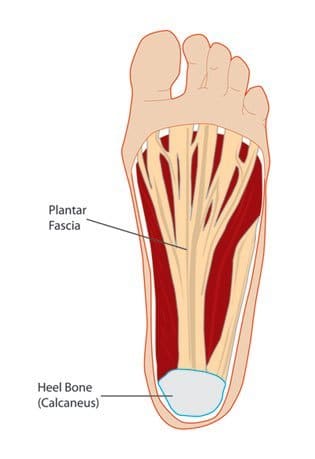The nodules are located just below the skin, usually in the central or inner part of the fascia (at the arch of the foot). They do not have a specific size and usually grow very slowly; however, it is also possible that a nodule that has remained unchanged for months or even years starts growing rapidly. There can be single or multiple nodules at a time.
Cause:
The precise cause of these nodules is yet to be discovered. Many speculate that these nodules occur as a result of repeated injury to the plantar fascia. Small puncture wounds or tears in the plantar fascia heal by the formation of scar tissue. An increased growth of this scar tissue at a localized point leads to the formation of these nodules.
In people with stiff calf muscles, the plantar fascia is exposed to a greater mechanical load and this may make it more prone to injury and thus to the development of plantar fibromas.
It has also been documented in persons suffering from epilepsy, liver cirrhosis, hypothyroidism and diabetes mellitus. Alcoholics are more prone to develop plantar fascia nodules. Also, persons using Phenytoin (Dilantin) an antiepileptic drug, can also develop these fibromas or nodules.
Some also consider heredity an important factor in the development of these nodules.
Symptoms:
Usually, these nodules do not cause any symptoms.
Mostly, the only symptom caused by these nodules is pain on walking, standing or wearing shoes, as these nodules change the regular contour of the lower surface of the foot. Usually, both feet are involved. If left untreated the condition may lead to contracture of the plantar fascia (in about 25% of cases), this causes stiffening and bending of the toes, which further hinders walking.
Diagnosis:
Clinical examination helps to diagnose the condition. For further confirmation the surgeon may advise an MRI or biopsy of the nodule.
Treatment:
Innersoles such as soft arch supports or padding is advised to overcome the pain on walking and wearing shoes.
Calf stretching may also help to loosen the stiff calf muscles and decrease the mechanical load on the plantar fascia. Heel lifts may also prove helpful in this regard.
Steroid injections at the site of the nodule also help to reduce its size and the discomfort that it causes. However, the nodules usually return back to their original size with time.
For constantly painful or large lesions, surgery is recommended. The overlying skin is incised to remove the nodule. There should be no weight bearing for at least three weeks following the surgery, to decrease the risk of excessive scar formation at the site.
However, these nodules have a high recurrence rate. In about 25% of cases, the nodules reappear after excision.






